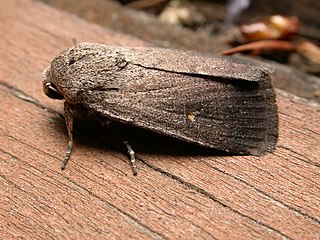
Lepidoptera is an order of insects that includes butterflies and moths. About 180,000 species of the Lepidoptera are described, in 126 families and 46 superfamilies, 10 percent of the total described species of living organisms. It is one of the most widespread and widely recognizable insect orders in the world. The Lepidoptera show many variations of the basic body structure that have evolved to gain advantages in lifestyle and distribution. Recent estimates suggest the order may have more species than earlier thought, and is among the four most speciose orders, along with the Hymenoptera, Diptera, and Coleoptera.

The Drepanidae are a family of moths with about 660 species described worldwide. They are generally divided in three subfamilies) which share the same type of hearing organ. Thyatirinae, previously often placed in their own family, bear a superficial resemblance to Noctuidae. Many species in the drepanid family have a distinctively hook-shaped apex to the fore wing, leading to their common name of hook-tips.

Coleophora is a very large genus of moths of the family Coleophoridae. It contains some 1,350 described species. The genus is represented on all continents, but the majority are found in the Nearctic and Palaearctic regions. Many authors have tried splitting the genus into numerous smaller ones, but most of these have not become widely accepted.

Gymnothorax is a genus of fish in the family Muraenidae found in Atlantic, Indian and Pacific Ocean. With more than 120 species, it the most speciose genus of moray eels.

Eupterotidae is a family of insects in the order Lepidoptera with more than 300 described species.

Urodidae or "false burnet moths" is a family of moths in the lepidopteran order. It is the type genus in the superfamily, Urodoidea, with three genera, one of which, Wockia, occurs in Europe.
Agathiphaga is a genus of moths, known as kauri moths. It is the only living in the family Agathiphagidae. This caddisfly-like lineage of primitive moths was first reported by Lionel Jack Dumbleton in 1952, as a new genus of Micropterigidae.

The Thyatirinae, or false owlet moths, are a subfamily of the moth family Drepanidae with about 200 species described. Until recently, most classifications treated this group as a separate family called Thyatiridae.

Proteuxoa is a genus of moths of the family Noctuidae. The genus was erected by George Hampson in 1903.
Trichasterina is a genus of fungi in the Asterinaceae family. The relationship of this taxon to other taxa within the class is unknown, and it has not yet been placed with certainty into any order.
Gymnothorax microspila is a moray eel found in the eastern Indian Ocean, around the East Indian Archipelago. It was first named by Albert Günther in 1870.
Proteuxoa microspila is a moth of the family Noctuidae. It is found in the Australian Capital Territory, New South Wales, Queensland, South Australia, Tasmania and Victoria.
Trichophysetis microspila is a moth in the family Crambidae. It is found on Sumbawa.
Hypsidia is a genus of moths belonging to the subfamily Thyatirinae of the Drepanidae. It was described by Walter Rothschild in 1896.
Hypsidia australica is a moth in the family Drepanidae. It was described by Sick in 1938. It is found in Australia, where it has been recorded from New South Wales.
Hypsidia grisea is a moth in the family Drepanidae. It was described by Malcolm J. Scoble and Edward David Edwards in 1988. It is found in Australia.
Hypsidia erythropsalis is a moth in the family Drepanidae. It was described by Walter Rothschild in 1896. It is found in Australia, where it has been recorded from northern Queensland. The habitat consists of rainforests.
Hypsidia robinsoni is a moth in the family Drepanidae. B.S. Hacobian described it in 1986. It is found in Australia, where it has been recorded from northern Queensland.
Eugene Gordon Munroe was a Canadian entomologist who discovered numerous species of insects. He worked for the Insect Systematics and Biological Control Unit, Entomology Division in Ottawa, Ontario, Canada.







